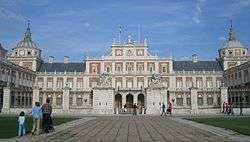Aranjuez
| Aranjuez | |||
|---|---|---|---|
| Municipality | |||
| |||
 Aranjuez  Aranjuez Location of Aranjuez within Spain / Community of Madrid | |||
| Coordinates: 40°02′00″N 3°36′10″W / 40.03333°N 3.60278°WCoordinates: 40°02′00″N 3°36′10″W / 40.03333°N 3.60278°W | |||
| Country |
| ||
| Autonomous Community |
| ||
| Comarca | Las Vegas | ||
| Municipality | Aranjuez | ||
| Government | |||
| • Mayor | Cristina Moreno Moreno (PSOE) | ||
| Area | |||
| • Total | 201.11 km2 (77.65 sq mi) | ||
| Elevation | 495 m (1,624 ft) | ||
| Population (2015) | |||
| • Total | 58,168 | ||
| • Density | 290/km2 (750/sq mi) | ||
| Demonym(s) | ribereño, arancentano | ||
| Patron saint | Nuestra Señora de las Angustias (September 15) | ||
| Website | www.aranjuez.es | ||
Aranjuez (Spanish pronunciation: [aɾaŋˈxweθ]), also called the Royal Estate of Aranjuez, is a city and municipality, capital of the Las Vegas district, in the southern part of the Community of Madrid, Spain. It is located at the confluence of the Tagus and Jarama rivers, 42 kilometres (26 mi) south of Madrid, and 44 kilometres (27 mi) from Toledo. As of 2009, it had a population of 54,055. It is the 17th-largest city in the Community of Madrid and the autonomous community's largest and most populous urban center outside Greater Madrid Area.
It has been one of the Royal Estates of the Crown of Spain since the times of Philip II in 1560. Until 1752, only the royalty and nobility were allowed to dwell in the town.
The Cultural Landscape of Aranjuez was declared a World Heritage Site by UNESCO in 2001.
History
There are several theories about the origin of the name. The most widely accepted one states that it comes from the Basque language, deriving from arantza ("hawthorn" in English). Another theory, attributed to Padre Martín Sarmiento, a Benedictine scholar who lived about a century after the founder of Aranjuez, Philip II of Spain, claims the origin to be from Latin Ara Jovis or Ara Iovia, which means the altar of the Roman god Jupiter also known as Zeus. However the pre-Roman derivation is generally preferred.
In 1178, the area was acquired by the Order of Santiago. Ferdinand and Isabella, the "Catholic monarchs", converted Aranjuez into a royal site. It was the Spring residence of the kings of Spain from the late 19th century.
During the reign of Philip II of Spain, in the second half of the 16th century, the royal palace was constructed and the name of the enlarged settlement was changed from Alpajes to Aranjuez. The site was initially designed by Juan Bautista de Toledo and completed by Juan de Herrera. The town, or Villa was extensively redesigned in the 18th century by Santiago Bonavía
Bourbon Aranjuez
| Aranjuez Cultural Landscape | |
|---|---|
| Official name: Aranjuez Cultural Landscape | |
| Type | Cultural |
| Criteria | ii, iv |
| Designated | 2001 (25th session) |
| Reference no. | 1044 |
| State Party | Spain |
| Region | Europe and North America |
Many significant events occurred here during the Enlightenment in Spain:
- 1752: During the reign of Ferdinand VI the town of Aranjuez, previously reserved for the royal family, nobles of the royal court and palace servants started to be opened as a town with overnight accommodation for visitors, who had previously been obliged to lodge in nearby settlements such as Ocaña. In that year the First Treaty of Aranjuez recognized Austrian and Spanish interests in Italy
- 1753: The weir in the Tagus River which is alongside to the Royal Palace of Aranjuez was constructed to power a water wheel for milling wheat flour. Since the mill was visible from the palace, it was architecturally attractive and sometimes used as the residence of the town governor. In the 20th century it was renovated to generate power, and was finally dismantled after a fire about 1950. As of 2014 only the mill races remained.
- 1758: Queen Barbara de Braganza, wife of Ferdinand VI, died in Aranjuez
- 1761: King Carlos III builds the so-called Long Bridge (about 300m long) over the river Jarama. This stone construction remains largely intact and now supports the M-305 service road about 5 km north of the town.
- 1765: Carlos III, a keen physiocrat orders the construction of Real Cortijo de San Isidro, a model farm which was abandoned by his successor (his second son, Charles IV of Spain) and later commercialized. The chapel and winery remain intact, both of which are national monuments open to the public
- 1765 Carlos III orders the construction of the Franciscan Convent of San Pascual, later occupied by the Conceptionists. During the time of Francoist Spain it served as a women's prison, and is currently a state assisted private church-run primary school. Opposite it he built Hospital San Carlos (abandoned in 1964 and now in ruins)
- 1766 Isabella Farnese, wife of Philip V of Spain and mother of Carlos III, who contributed greatly to the town's development, died in Aranjuez
- 1767: The French architect Jaime Marquet began construction of the theatre Coliseo Carlos III, recently restored and reopened as Theatro Carlos III in 2014
- 1777: In the 3rd Treaty of Aranjuez France and Spain define their colonies in Santo Domingo
- 1779: Spain becomes involved in the War of Independence of the United States by virtue of the 3rd Treaty of Aranjuez
- 1780 The 4th Treaty of Aranjuez, cedes Spanish territories in Africa to Morocco
- 1801 In the 5th Treaty of Aranjuez, publicly confirms the secret Third Treaty of San Ildefonso in which Spain returned the colonial territory of Louisiana to France.
- 1808 The Mutiny of Aranjuez. An uprising on 17 March 1808, when the royal family and the government were staying at Aranjuez while on their way south, anticipating a French invasion from the north. Soldiers, peasants and members of the general public assaulted Godoy's quarters and captured him. The mutineers made King Charles dismiss Godoy, and two days later the court forced the King himself to abdicate in favor of his son and rival, who became Ferdinand VII.
- 1833 Queen Isabella II of Spain acceded to the throne and finally Aranjuez was reached by a railway line to Madrid in 1851. (a dramatized film of the event shows the former station and temporary rails leading into the palace, which is historically reasonably accurate). This was the second railway line in Spain, after that of Barcelona-Mataró (1848).
In 1939, Joaquín Rodrigo composed the Concierto de Aranjuez, which would make Aranjuez famous all over the world.
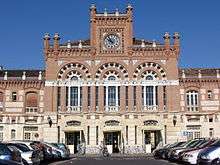
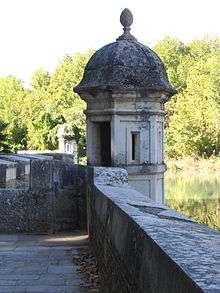
Main sites
The city was declared Conjunto Histórico-Artístico ("Historic Artistic Junction") in 1983. In 2001 UNESCO listed the Aranjuez Cultural landscape as a World Heritage Site.
Mariblanca
This was the first extension beyond the Royal Palace, along the south bank of the river Tagus (Local spelling Tajo). The royal Church of San Antonio which was built by Philip IV of Spain for both public and ceremonial royal use, stands at the southern end of Plaza San Antonio popularly known as Mariblanca, (possibly because it is a 'sea' of white sand or mar de arena blanca or else an allusion to the female statue of the fountain at the far end, which is the Venus of sculptor Juan Reyna in 1762).
This is now an occasional festival ground which is lined on the west by the quarters of the officers (Casa de Oficios) and knights (Casa de Caballeros now Juzgados or law courts facility) and on the west by the Casa de las Infantas (built by Charles II of Spain for his sons Gabriel and Antonio, which now houses the tourist office).
To the north is the cobbled Santiago Rusiñol roundabout which links the Madrid road (M305/A4) with Calle de la Reina and the two grand boulevards av.del Principe and av. de las Infantas as well as the roads along the side of Plaza San Antonio/Mariblanca, the south-bound calle Florida and northbound Antigua Carretera de Andalucía.
Plaza de Toros

A bullring, one of the earliest in Spain, the original was built in 1760 by order of King Charles IV, the refurbished structure was opened by his wife, Maria Luisa of Parma, on 14 May 1797. It had a capacity of 9000 spectators at a time when the population, according to the then prime minister, was only 4226. There are twelve public entrances which lead to three circular galleries, each with 10 stone seating benches. Royalty and their guests enjoyed a private entrance with stairs leading directly to the royal box.
Following a fire in 1809, King Ferdinand VII had it rebuilt and donated it to the town, which installed a small museum (usually only open to the public Saturday, Sunday and Monday mornings at 11.15)[1]
Buildings
Sights in the city include many buildings in addition to the 17th century Royal Palace and church mentioned above:
- House of Trades and Knights
- House of Infantes and Atarfe
- Pleasure craft Museum
- Farmhand's House
- House of Employees (currently Town Hall)
- Alpajes Church
- Saint Pascual's Royal Convent
- Old Saint Charles' Hospital (to be restored)
- Charles III's Royal Theatre (recently restored and reopened in 2014)
- Supply Market
- Plaza de Toros and Bullfighting Museum "Una Gran Fiesta"
- Medinaceli Palace
- Governor's House (currently University of High Studies Centre Philip II)
- Mother Queen's old garage, today cultural centre "Isabel de Farnesio"
- Typical 'corralas' (buildings with running balconies around a central courtyard)
- Godoy and Osuna Palaces
- Silvela's Palace (also known as Bavaria's Palace)
- Royal Country Estate of Saint Isidro
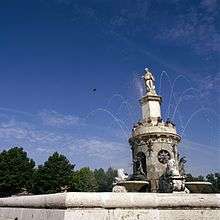
Parks and gardens
Numerous parks and gardens are open to the public (detailed in )
- Isle Garden – to the north of the palace, bordered by the river (beyond weir) and a broad irrigation canal
- Parterre Garden The formal garden and fountains in front of the palace and to the north of Mariblanca/San Isadro
- Prince's Garden Along the river to the east, bordered by Calle de la Reina
- Isabella II's Garden a small formal garden adjacent to Mariblanca/San Isidro
- Historical thickets and woodlands
- Centre of Interpretation of the Natural Reserve "El Regajal-Mar de Ontígola"
- Tree-lined walks and rides through the former nursery gardens (now agriculture) at Doce Calles (12 ways roundabout on M-305 Northbound to Madrid)

Government and administration
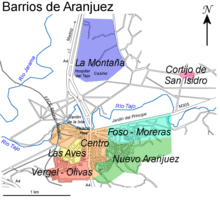
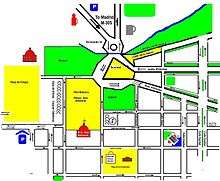
The city of Aranjuez is governed by a single municipal authority, which, for convenience divides into the several administrative districts which in turn may contain residential estates (urbanizaciones):
- Centro, includes the royal sites, the bullring and the historic town center, with central market and shopping
- Vergel – Olivas,
- Polígono de Las Aves, to the west near the railway station, near Pirelli & Jardín Narváez
- Nuevo Aranjuez, to the south, on higher ground
- Foso – Moreras associated with Garden City of Agfa, and ambitious, but as yet incomplete project
- Urbanización Mirador de Aranjuez A vast, mostly failed (turn of the 20th–21st century) house-building project on a steep southerly slope overlooking the old town.
- La Montaña – new (turn of the 20th–21st century) district of about 5000 homes (Many 'toxic assets' still vacant) about 3 km (1.9 mi) north of the town. It has the district Hospital-Tajo, a 4-star Hotel-Barcelo with spa and 18-hole golf-course, Gran-Casino, La Finca event venue, a vast commercial centre (Plaza) and car-park which was built but never opened, and a business campus Centro Empresial which contains the small-business support unit APME, a substantial supermarket and a few small businesses. Various shops are to be found elsewhere about the barrio. The residents Association is known as Asociación de Vecinos del Barrio de la Montaña or AVBM.
- Cortijo de San Isidro, a small residential settlement around a former royal hunting lodge, a volunteer sub-council represents residents interests.
Economy
The main pillars of the local economy are hotels and tourism. Aranjuez has always been an attractive city for tourists with its Royal Palace, the gardens, the Tagus river and the landscapes. In 2001 this city was designated as a World Heritage Cultural landscape by UNESCO, and since then, tourism has kept on increasing until hit by the 2008 recession. Prior to 2008 much money was spent in order to beautify Aranjuez and many pubs and restaurants were opened (from 2001 to 2004 their number increased 22%).
La Montaña
This was a 'pharonic' proyecto de Actuación Urbanística (PAU) of some 5000 mixed 'open market homes (Viviendas precio libre or VPL) of which, by 2012, something around one fifth were actually sold. The remainder are now owned by the 'bad bank' SAREB In 2005 a major events and gambling installation Gran Casino was opened in the (northern) barrio Montaña near the existing conference centers of La Finca and Hotel Barcelo (which includes an 18-hole golf course). Nearby, the ambitious Plaza commercial center, built but not fitted, has never opened, and the smaller enterprise center, although open, contains a local supermarket, two cafés and less than a dozen other small businesses. Finally, in March 2008 the University Hospital Tajo was opened. In 2013 this hospital, together with several others medical facilities in the Community of Madrid was threatened with privatisation, provoking considerable public protest known as the Marea Blanca (the white (coat) wave or tide).
Agriculture
Aranjuez is located on the fertile plain in the deep, high sided valley (cuenca) of the river Tagus (the comarca Vega del Tajo), whose rich soil is suitable for growing wheat and other cereals. There are also horticultural plantations, notably of asparagus and strawberries but also (centered on Villaconejos) vineyards and extensive production of melons. Typical of the neighbouring region of Castilla-La Mancha Aranjuez and the Vega del Tajo also produce a wide variety of products such as sorghum, sunflowers, potatoes, tomatoes, artichokes, beets and Jalapeño peppers.
The Real Cortijo de San Isidro is a settlement about 6 km north of Aranjuez where King Charles III of Spain established a royal farm in 1766, exploiting existing agricultural land. There is a village with a royal chapel (Hermitage) and a wine cellar (Bodegas del Real Cortijo de San Isidro)
Industry
The proximity to Madrid and the good communications by road and rail made Aranjuez a suitable location for industry: detergents, Mechanical engineering, computer and electrical material, photographic materials, pharmaceutical products, paints and varnishes, sugar refineries, and oil mills.
The majority of the industries are located to the west of the railway station or in the "Gonzalo Chacón" industrial park, in the south. The main existing industries are:
- Indra Sistemas (Defence and high technology computer & informatics systems).[2]
- Electrónica Aranjuez (EASA) (High technology & defence electronics), part of grupo Espacio Industrial.[3]
- Bosch (electrical components for automobiles).[4]
- Carburos Metálicos Medical & industrial gasses and chemicals.[5]
- FYSE Pharmaceuticals, a division of / Ercros Industrial S.A.[6]
- Cortefiel, a garment logistics facility for a retail company marketing brands such as Springfield, women'secret, Fifty Factory, Antonio Miró Studio and Pedro del Hierro Fashion[7]
- Embalajes Castro S.A. Packaging specialists
Previous industrial activities now reduced, mothballed or closed included
- Lever Brothers (manufacture and packaging of detergents)
- API Fabricación (Road signalization) part of grupo Imesapi[8]
- ISN (formerly Fruehauf) trailer manufacture & precision plastics for transport industry[9]
- Near the station there is also extensive unused railway sidings, warehouses and a sugar refining plant all presumably abandoned in the early part of the 20th century[10]
- Agfa film: ECESA (Estudios Cinema Español), S.A.created in 1931, reformed in 1935 as E.A.S.A. (Estudios de Aranjuez, Sociedad Anónima) but made few films. In 1950 (MAFE (Manufacturas Fotográficas Españolas, S.A.) started to produce photographic film, and was absorbed into Agfa in 1964 before being closed definitively in 2001.[11]
Transportation
Aranjuez enjoys excellent road and rail links to the Spanish capital city of Madrid.
Road
Aranjuez is served by the public Autovía A-4 (Madrid Cordoba) The exit at kilometre 37 connects to the M-305 (regular road which leads via La Montaña district and automotive sales zone (3 km north of city) and then directly to the royal palace. The A4 exit at kilometre 52 serves the south of the town, as does the toll road Radial R-4.
Six main line bus routes serve the locality via the bus station, Las Infantas. Taxis and local bus services (four routes) link to the railway station.
The municipality provides a free public pedal bicycle scheme although there is a modest registration fee.
There is also a tourist Chiquitren road train which tours the town and the extensive jardin del principe royal garden.
Rail
Aranjuez railway station building is richly ornamented in the neomudéjar style. It was built by the then operator Compañía de los Ferrocarriles de Madrid a Zaragoza y Alicante between 1922 and 1927. It was recently renovated by RENFE, who operate an hourly shuttle service to Madrid and medium distance services to other destinations. The Strawberry train is a special Steam locomotive Heritage railway service provided for summer visitors and tourists.
River
The river is obstructed and so used only by a local tourist boat and canoeists. There is an annual fun rafting competition run by the pirates of the tajo.
An ancient irrigation system for the royal kitchen-gardens and orchards (now farmland) includes channels and a noria waterwheel, recently restored in a leisure area known as Talud Sur (south bank of) de La Montaña de Aranjuez. The old, tree-lined avenues around are maintained provide shady level walkways.
Local media
Print media
- Heraldo de Aranjuez.
- Tablón de Anuncios.
- Consumo Digital.
- Cuatro Esquinas.
- Divergente.
- El Espejo.
Radio stations
- Onda Aranjuez, 107.8 FM.
- Cadena Ser Aranjuez, 89.3 FM.
- Onda Cero Aranjuez, 90.7 FM.
- Radio Fuga, 92.1 FM.
Sports facilities
- The city has a long tradition of water sports due to its connection with the Tagus river, such as canoeing, stand-up paddleboarding and rowing. In the Olympic bid of Madrid for the 2012 Olympics, which were held in London, Aranjuez was the selected site for these sports. In spite of this, there are plans to continue the construction of the necessary sport facilities, which should be finished by 2010.
- Aranjuez has a football team, Real Aranjuez C.F., which plays in the Local Stadium, called "El Deleite".
- Nearby Ocaña has a skydiving and gliding centre at the Aerodrome, and most of the skydivers there base themselves in Aranjuez.
Notable people
- Infante Carlos, Count of Molina (1788–1855), Infante of Spain and claimant to the throne.
- Francisco Clavet, tennis player.
- Francis, Duke of Cadiz, husband of queen Isabella II of Spain.
- Javier García Portillo, football player.
- Ángel Parra, judoka.
- Joaquín Rodrigo, composer and 1st Marqués de los Jardines de Aranjuez.
- Santiago Rusiñol, painter.
- Jose Luis Sampedro, writer.
- Iván Sánchez-Rico Soto alias Riki, football player.
- Francisco Agustín Silvela y Blanco, Minister of Gobernación and Gracia y Justicia. Vice-President of the Congress of Deputies and Magistrate of the Supreme Court.
- Carlos Suarez, basketball player.
Aranjuez in the arts
.jpg)
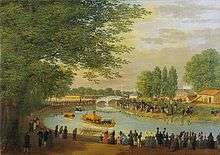
Rodrigo wrote the Concierto de Aranjuez (1939) for guitar and orchestra which was inspired by the royal gardens of Aranjuez and became one of the most famous orchestral compositions of the 20th century.
The Austrian writer Peter Handke wrote the play Die schönen Tage von Aranjuez (The beautiful days of Aranjuez), which translated into English by which Michael Roloff.
Culture
Traditions
- In summer it is traditional to eat dinner in the picnic areas next to the Tagus river. These places are called gangos, a Spanish word used only in Aranjuez.
Festivals

- Alfaranjuez In May – includes a Craft Fair with Folk Aranjuez Traditional Music Festival and a used vehicle fair.
- San Isidro Labrador day, 15 May, pilgrimage in the nearby hunting lodge of Real Cortijo de San Isidro.
- San Fernando town festival week, around 30 May, parades and events.
- 'Early Music Festival Aranjuez, held in about May or June
- Book Fair Aranjuez, in contrast with the Used Book Fair and Sale, held in September.
- Mutiny of Aranjuez re-enactment about first week of September, declared a cultural event of National Tourist Interest, which includes
- a funfair (car park, M-305),
- sports events (Delete stadium),
- food and drink stalls (Mariblanca),
- a concert at the Royal Palace,
- a traditional or Sacrificio Goyesque (in the Plaza de Toros),
- a dramatic street re-enactment of the flaming torch attack and capture of Godoy at his Palace, (that building now houses a school) with fireworks and costumes inspired by Goya paintings.
- A fun raft-race organized by the pirates of the Tajo social club
Gastronomy
- Local horticultural produce, especially strawberries and asparagus. Also (sweet, green) toadskin melons, olive oil and local wine from nearby comarca 'Las Vagas' which includes Villaconejos – Chinchón agricultural areas
- Pheasant, a characteristic gamebird from the area's forests.
Twin towns - sister cities
| Town | State/Region | Country |
|---|---|---|
| Écija | |
|
| Le Pecq | |
|
Other towns within the municipality
- Algodor
- Castillejo
- Las Infantas
- Real Cortijo de San Isidro
References
- ↑ "Plaza de toros" (in Spanish). Turismo in Aranjuez (official site). Retrieved 19 July 2013.
- ↑ Web de Indra Sistemas
- ↑ Web of Electrónica Aranjuez Archived 28 July 2013 at the Wayback Machine.
- ↑ Web of Robert Bosch Archived 19 July 2012 at the Wayback Machine.
- ↑ Web of Carburos Metálicos Archived 12 January 2014 at the Wayback Machine.
- ↑ Web of Ercros – Fyse Archived 17 June 2012 at the Wayback Machine.
- ↑ Web of Cortefiel
- ↑ Web of Imeaspi
- ↑ Web of ISN
- ↑ Web of Forgotten Places
- ↑ Report (in Spanish) by historias-cinematograficas de España
External links
| Wikimedia Commons has media related to Aranjuez. |
- wikivoyage:Aranjuez Wikimedia tourist guide project (in English)
- Official homepage of Aranjuez City Council (in Spanish)
- Official Tourist Agency website with comprehensive professional photographs of main attractions (in Spanish)


